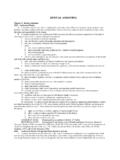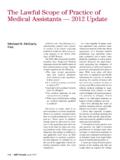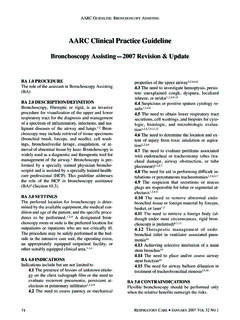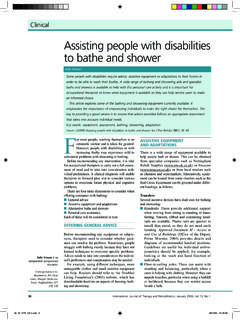Transcription of Assisting in Ophthalmology - Online Resources for …
1 Copyright 2011, 2007, 2003, 1999 by Saunders, an imprint of Elsevier Inc. All rights reserved. Assisting in Ophthalmology Copyright 2011, 2007, 2003, 1999 by Saunders, an imprint of Elsevier Inc. All rights reserved. Learning Objectives Define, spell, and pronounce the terms listed in the vocabulary. Apply critical thinking skills in performing patient assessment and care. Explain the differences among an ophthalmologist, optometrist, and optician. Identify the anatomic structures of the eye. Describe how vision occurs. Differentiate among the major types of refractive errors. Copyright 2011, 2007, 2003, 1999 by Saunders, an imprint of Elsevier Inc. All rights reserved. Learning Objectives Summarize typical disorders of the eye. Define the various diagnostic procedures for the eye.
2 Conduct a vision acuity test using the Snellen chart. Assess color acuity. Illustrate the purpose of eye irrigations and the instillation of medication. Properly irrigate a patient s eyes. Accurately instill eye medication. Copyright 2011, 2007, 2003, 1999 by Saunders, an imprint of Elsevier Inc. All rights reserved. Examination of the Eye The ophthalmologist is a medical physician specializing in the diagnosis and treatment of the eye. The optometrist examines and treats visual defects. An optician fills prescriptions for corrective lenses. Copyright 2011, 2007, 2003, 1999 by Saunders, an imprint of Elsevier Inc. All rights reserved. Anatomy and Physiology of the Eye The anatomy of the eye begins with the outer covering, the conjunctiva, and the three layers of tissue: sclera, choroid, and retina.
3 The retina in the inner layer of the eye is where light rays are converted into nervous energy for interpretation by the brain. The lens is a transparent body that helps focus light after it passes through the cornea. The posterior cavity contains vitreous humor and the anterior cavity contains aqueous humor. Copyright 2011, 2007, 2003, 1999 by Saunders, an imprint of Elsevier Inc. All rights reserved. Vision Vision begins with the passage of light through the cornea, where it is refracted and then passes through the aqueous humor and pupil into the lens. The ciliary muscle adjusts the curvature of the lens to refract the light rays so they pass into the retina, triggering the photoreceptor cells of the rods and cones. Light energy is then converted into an electrical impulse, which is sent through the optic nerve to the brain, where interpretation occurs.
4 Copyright 2011, 2007, 2003, 1999 by Saunders, an imprint of Elsevier Inc. All rights reserved. Disorders of the Eye Refractive errors: Hyperopia Myopia Presbyopia Astigmatism All are caused by a problem with bending light so it can be accurately focused on the retina. They are usually caused by defects in the shape of the eyeball and can be corrected with glasses, contact lenses, or surgery. Copyright 2011, 2007, 2003, 1999 by Saunders, an imprint of Elsevier Inc. All rights reserved. Signs and Symptoms of Refractive Errors Squinting Frequent rubbing of the eyes Headaches Blurring of vision and/or fading of words at reading level Some refractive errors are familial in nature Copyright 2011, 2007, 2003, 1999 by Saunders, an imprint of Elsevier Inc.
5 All rights reserved. Treatment of Refractive Errors Eyeglasses and contact lenses Photorefractive Keratectomy (PRK) Laser-Assisted In-Situ Keratomileusis (LASIK) Laser-Assisted Epithelial Keratomileusis (LASEK) Conductive Keratoplasty (CK) Copyright 2011, 2007, 2003, 1999 by Saunders, an imprint of Elsevier Inc. All rights reserved. Cataracts Cataracts opaque changes in the lens; cause blurred, less acute vision. Diagnosis made with a slit lamp Treatment outpatient surgical removal of lens and placement of artificial lens Extracapsular extraction removes cataract in one piece Copyright 2011, 2007, 2003, 1999 by Saunders, an imprint of Elsevier Inc. All rights reserved. Glaucoma Aqueous humor builds up, increasing intraocular pressure and decreasing blood supply to retina and optic nerve Signs and symptoms frequent need to change eyeglass prescriptions, loss of peripheral vision, mild headaches, and impaired adaptation to the dark Diagnosis tonometer and eye examination Treatment miotic drops, beta-blockers, or laser surgery Copyright 2011, 2007, 2003, 1999 by Saunders, an imprint of Elsevier Inc.
6 All rights reserved. Macular Degeneration Macula lutea is part of the retina and defines the center of the field of vision Progressive deterioration of macula lutea causes progressive loss of central vision Age-related; no cure antioxidants including carotene, selenium, zinc, and vitamins C and E may prevent the condition or slow its progress Copyright 2011, 2007, 2003, 1999 by Saunders, an imprint of Elsevier Inc. All rights reserved. Distance Visual Acuity Distance visual acuity is typically assessed using a Snellen chart. May use E chart, pediatric picture chart, or alphabet chart Patient stands 20 feet from chart at eye level Eyes tested with corrective lenses worn Record results as fraction with 20 feet on top Both eyes remain open during the examination; no squinting or straining Abbreviations: OD (right), OS (left), OU (both) Copyright 2011, 2007, 2003, 1999 by Saunders, an imprint of Elsevier Inc.
7 All rights reserved. Types of Snellen Charts Copyright 2011, 2007, 2003, 1999 by Saunders, an imprint of Elsevier Inc. All rights reserved. Treatment Procedures: Irrigations Eye irrigations relieve inflammation, remove drainage, dilute chemicals, or wash away foreign bodies. Sterile technique and equipment must be used to avoid contamination. Pour solution from inner canthus out, with head tilted toward the affected eye. Procedure 37-3 Copyright 2011, 2007, 2003, 1999 by Saunders, an imprint of Elsevier Inc. All rights reserved. Eye Irrigation Copyright 2011, 2007, 2003, 1999 by Saunders, an imprint of Elsevier Inc. All rights reserved. Ophthalmic Medication Procedures Medication may be instilled into the eye for treatment of an infection, to soothe an eye irritation, to anesthetize the eye, or to dilate the pupils before examination or treatment.
8 Eye drops do not touch anything with applicator; insert into lower conjunctival sac while patient looks up. Eye ung sterile procedure; apply thin ribbon of medication in lower conjunctival sac. Patient should gently close eye after application and rotate eyeball to disperse medication. Refer to Table 37-2 Copyright 2011, 2007, 2003, 1999 by Saunders, an imprint of Elsevier Inc. All rights reserved. Asepsis and Ophthalmic Medications A major concern in ophthalmologic procedures is the contamination of eye medication applicators Use of stock ophthalmic medications is discouraged Sterility of eye medications is critical Newly opened sterile solutions should be used for each patient and either disposed of after instillation or given to the patient for home use All instruments used for the removal of a foreign body in the eye should be sterile











